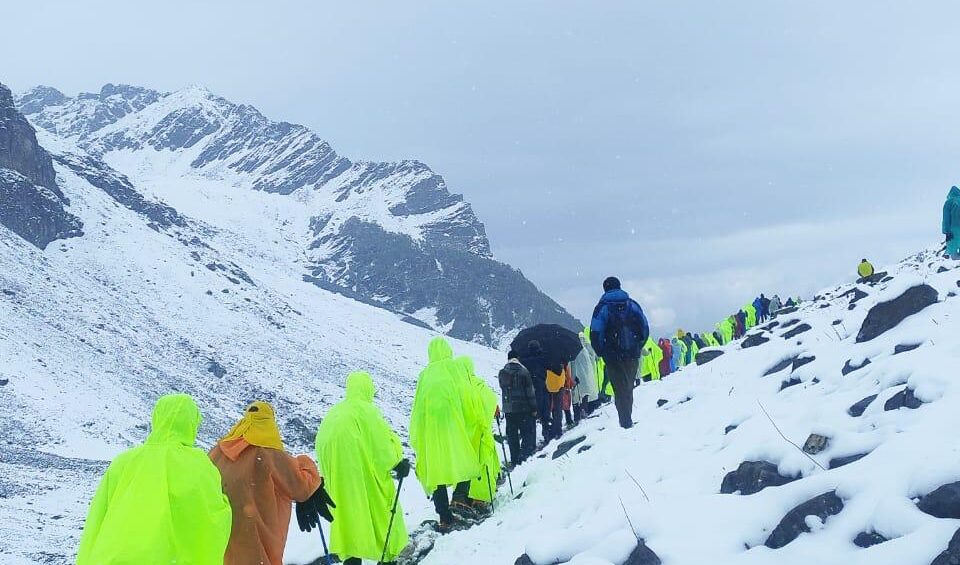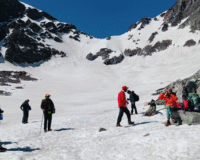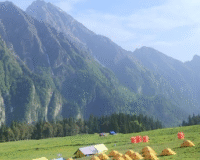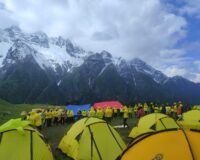Rupin Pass Trek is a famous high trek in the Indian Himalayas, known for its dramatic landscape changes, challenging terrain, and for fantastic scenery. It is a cross-over-Trek, which starts in Uttarakhand and ends in Himachal Pradesh, providing a unique blend of cultural immersion and raw natural beauty to hikers. For “Pahdi trekkers”, this walk should be an absolute, which embodies the spirit of the Himalayas adventure.
What makes Rupin Pass so captivating is that it has an incredible variety. Over the course of 7-8 days you will see a complete change of scenes from lush green valleys and dense forests to alpine meadows and expands.
The Verdant Binning: Dhaula and Service
The journey usually starts from Dhaula in Uttarakhand, a small village surrounded by the Rupin River. The first days of the trip include service and go through attractive, remote villages such as Jekun. Here you get a glimpse of the local lifestyle, and stick to the hills with traditional wooden houses and terraced fields. Through the dense forests of oak, pine and rhododendron, the trail meanders, the canopy gives a fresh coolness. The wind is sharp, filled with pine smell, and the melodic bird’s suffocating is with your footsteps.
The Hanging Village: Jakha
Rupin passes one of the most prestigious stops on the passenger trip, often called “Hanging Village”. The houses are built so quickly on the mountain that they are suspended in the air. This unique architectural miracle is a will for the simplicity of the locals in being adapted to the challenging terrain. Jakha from Uttarakhand is also the last important settlement from Uttarakhand before entering the parts of the trip, which is an important point for starting and acclimatizing.
The Land of Waterfalls and Meadows: Dhanderas Thatch
When you climb, the landscape changes gradually. The forests give way to the spacious, open alpine grasslands, known as “Thach”. Dhanderus Thach is an attraction, a huge green expansion, surrounded by peaks.
Whoever actually separates it is a Royal Rupin foss, a multi-level cascade that dramatically falls down the mountain. Camping near the waterfall of this thunder is an unforgettable experience, its roar is a constant partner. In the summer months (May-June), these grasslands burst into a riot of colors with a wildflower, including the famous Brahma Lotus with high access.
Sneaky Climbing: Upper Foss and Passport

The last pressure on the Rupin pass is undoubtedly the most challenging, but also the most beneficial. From Dhandaras Thach you track Upper Waterfall Camp, where the landscape is quickly robust and covered with snow, especially in early weather. You can withstand impressive snow bridges, which are formed by an exciting and often melting ice on icy harsh.
The next day is a test of endurance and spirit in itself. At the beginning of the morning, navigate through steep ice yellows and rocky sections. Rupin Pass, located at an altitude of about 4650 m (15,250 feet) to 4700 m (15 350 feet), is a saddle-shaped hill that offers panoramic views of the surrounding Himalaya mountains, including a glimpse of Royal Eunuch Kailash Peak. When you stand over the passport surrounded by the world of snow-covered veterans, the feeling of achievement is really unique.
Dynasty in Kinnur: Ronti Gad and Sangla
The descent from Rupin Pass is just as dramatic. You push the long snow field, an exciting and fun experience (allowed weather), which makes Ronty Gad alpine. The landscape here again infection, which gives a glimpse of the asymmetrical valley. The final phase of the trip takes you through several forests and villages, and finally leads to Sangla, a picturesque town in the Baspa valley Kinnur, Himachal Pradesh, is known for its unique culture and apple gardens.
Difficulty level and preparation
Rupin Pass Trek is usually classified as moderate to difficult. While the covered daily distance is manageable (more than 5-6 hours more than 5-6 hours 5-6 km), significant altitude benefits, steep rising and declining, different areas (including rocky trails, manual trails and wide ice spaces) and unexpected weather conditions contribute to its challenging nature.
Physical form is crucial: enjoying the trip and reducing the risk, hikers should have a stiff fitness diet at least one or two months before the campaign. It should be included:
- Cardiovascular training: running, jogging, cycling, swimming to create endurance. Dimensions for at least 5 km of jogging in 30 minutes.
- Shakti training: Focus on legs and nuclear strength to handle rising and sink with a backpack.
- Endurance building: Hiking with a weighted backpack to simulate walking conditions.
- Acclimatization: Due to the benefits of rapid height, proper acclimatization is important to prevent acute mountain disease (AMS). Eminent traction companies include acclimatization days on the journey, allowing oxygen levels of deficiency in your body. It is important to stay hydrated, maintain a slow and stable speed, and immediately report any symptoms of AMS
Best Time to Trek Rupin Pass
The Rupin Pass trek is best undertaken during two distinct windows:
- Summer Season (Late May to Early July): This is when the trail is characterized by snow bridges and melting ice in the higher sections, offering a true “winter wonderland” experience at the pass. The lower regions are lush green with blooming rhododendrons. Temperatures range from 12°C to 18°C during the day and can drop to 0°C to 7°C at night at lower camps, and even below freezing at higher camps.
- Autumn Season (Mid-September to Mid-October): The monsoon rains have receded, leaving behind clear skies and crisp air. The trails are generally drier and more stable, with little to no snow. This season offers spectacular panoramic views of the snow-capped peaks against a clear blue backdrop. Day temperatures are similar to summer (10°C to 16°C), but nights get colder, potentially dropping to -2°C to 5°C.
- Avoid the Monsoon Season (July to early September): The heavy rainfall can lead to slippery trails, landslides, and an increased presence of leeches, making the trek significantly more challenging and risky.
Essential Gear and Packing List
Packing smart is key to a comfortable and safe Rupin Pass trek. Here’s a general checklist:
Clothing (Layered System):
- Thermal base layers (top and bottom)
- Fleece jacket
- Down jacket (for higher altitudes)
- Trekking pants (quick-drying)
- T-shirts (quick-drying)
- Waterproof and windproof outer shell jacket and pants
Footwear:
- Sturdy, waterproof trekking boots with good ankle support
- Camp shoes/sandals
- Woolen and synthetic socks (multiple pairs)
Headgear:
- Woolen cap/beanie
- Sun cap/hat
- Balaclava or neck gaiter
Hands:
- Warm, waterproof gloves
- Fleece gloves (inner)
Backpack:
- Large trekking backpack (50-70 liters) with rain cover
- Small daypack (10-20 liters) for summit day or daily essentials
Sleeping:
- Sleeping bag rated for cold temperatures (your trekking company usually provides this)
Essentials:
- Trekking poles (highly recommended for stability and reducing strain)
- Headlamp with extra batteries
- Water bottles/hydration bladder (at least 2 liters capacity)
- Personal first-aid kit with any personal medications
- Sunscreen (high SPF)
- Lip balm with SPF
- Sunglasses (UV protection)
- Toiletries (biodegradable options preferred)
- Small quick-drying towel
- Power bank/portable charger
- Camera (optional, but highly recommended!)
- Snacks (energy bars, dry fruits, nuts)
- Personal identification and necessary permits (check with your trekking company)
Permits and Regulations
While specific requirements can vary, you will generally need:
- Inner Line Permit: As the trek crosses into a border region of Himachal Pradesh, an Inner Line Permit might be required. This is usually handled by your trekking company.
- Trekking Fees: There might be certain trekking fees to enter the region or for camping in designated areas.
- Valid ID: Always carry original and photocopies of your government-issued ID (Aadhar Card, Passport, Driver’s License, Voter ID).
It is always advisable to check the latest permit requirements with your chosen trekking company or local authorities before embarking on the trek.
The “Pahadi Trekkers” Experience

For those who resonate with the spirit of “Pahadi Trekkers,” the Rupin Pass offers more than just a physical challenge. It’s an immersion into the raw, untamed beauty of the Himalayas. You’ll encounter:
- Rustic Villages: Witnessing the simple yet resilient life of the mountain communities.
- Thundering Waterfalls: The constant presence of the Rupin River and its numerous cascades adds to the trek’s charm.
- Snow-Kissed Landscapes: The pristine snowfields and challenging snow traverses are a hallmark of this high-altitude journey.
- Diverse Flora and Fauna: From dense coniferous forests to alpine meadows teeming with wildflowers, the biodiversity is remarkable.
- The Thrill of a Cross-Over: Experiencing the distinct geographical and cultural shifts as you move from Uttarakhand to Himachal Pradesh.
Conclusion
The Rupin Pass trek is a profound adventure that challenges your limits and rewards you with unparalleled natural grandeur and a deep sense of accomplishment. It’s a journey that will stay with you long after you’ve returned from the mountains, truly embodying the essence of a “Pahadi Trekkers” dream.
FAQS
What is the Rupin Pass Trek?
The Rupin Pass trek is a renowned high-altitude trek in the Indian Himalayas, known for its contrasting landscapes. It acts as a crossover trek, typically starting in Dhaula, Uttarakhand, and ending in Sangla, Himachal Pradesh. The pass itself is situated at an elevation of approximately 4,650 meters (15,250 feet) above sea level.
How difficult is the Rupin Pass Trek?
The Rupin Pass trek is generally considered to be of moderate to difficult level. While daily distances are manageable and elevation gain is gradual, the trail presents challenges like steep ascents and descents, narrow paths, river crossings, and sections with loose rocks and scree. It’s recommended for trekkers with some prior experience and good physical fitness.
What are the main attractions and highlights of the Rupin Pass Trek?
The Rupin Pass trek is famous for its diverse and constantly changing scenery. Key highlights include:
- The Rupin River: You’ll follow the river closely, witnessing its many forms from a gushing torrent to a gentle stream.
- Rupin Waterfall: A majestic, multi-tiered waterfall that you ascend to and even camp near.
- Jhaka Village (The Hanging Village): A unique village perched dramatically on a cliffside, appearing to “hang” from the mountain.
- Dandreyash Thatch: Beautiful open meadows surrounded by towering peaks, often serving as a picturesque campsite.
- Snowfields and Glacial Valleys: Especially during the early season, you’ll encounter extensive snow stretches, including snow bridges.
- Dense Forests: Trekking through pine, oak, and rhododendron forests adds to the diverse experience.
- Panoramic Views: Breathtaking views from the pass itself, offering glimpses of the Kinnauri mountains and the Kinner Kailash range.
- Cultural Exposure: Opportunities to experience local culture and traditional villages along the way.
How long does the Rupin Pass Trek take?
The Rupin Pass trek typically takes 7 to 9 days to complete, depending on the chosen itinerary, the trekker’s pace, and weather conditions. This usually includes travel to and from the base camp.





